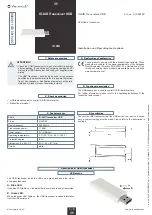
Subject to modifications.
© Vestamatic GmbH
Art.-Nr.:
0000 006 GB 0918 A02 • Vestamatic GmbH • Dohrweg 27 • D-41066 Mönchengladbach
• www.vestamatic.com
2/2
G
IO-AIR Transceiver USB
8. Installation
The IO-AIR transceiver is powered by a USB socket and receives its
operating voltage via this port. The maximum current consumption is < 40mA.
The required driver for the IO-AIR transceiver is usually installed directly.
If this does not work, you can download the driver for free via the link
below:
http://www.ftdichip.com/
If the transceiver is recognized correctly, a new COM interface can be
seen in the Device Manager of Windows under Ports (COM & LPT).
NOTE:
The number of the interface (COM X) depends on the number of
previously installed interfaces.
i
12. Service
/
Contact
Vestamatic GmbH
Dohrweg 27
D-41066 Mönchengladbach / Germany
Tel.: +49 2161 / 29 408-0
10. Warranty
Principally, the General Terms and Conditions of the manufacturer, Vestamatic
GmbH apply. The terms and conditions are part of the sales documents
and handed over to the operator upon delivery. Liability claims for personal
or material damages are excluded when they can be attributed to one or
more of the following causes:
– Unintended use of the product.
– Opening of the product by the customer.
– Improper installation, commissioning, or operation of the product.
– Non-compliance with the technical specifications.
– Non-observance of the safety provisions and instructions of the Oper-
ating Instructions.
– Operation of the product with improperly installed connections, defective
safety devices or improperly installed safeguards.
– Modifications to the product.
The disposal of electrical equipment and batteries in household
waste is strictly forbidden.
The symbol (dustbin crossed out, in line with WEEE Appendix IV)
indicates separate collection of electrical and electronic products in
EU countries. Do not dispose of the device or battery in your house-
hold waste. Ask your town or local council about the return and
collection systems available in your area to dispose of this product.
É
11. Disposal of waste
9. Instructions for radio receiver
ATTENTION!
Radio transmission is not suitable for safety operations,
such as emergency-stop, emergency call or warning signals.
Ä
Signals are transmitted across the Europe-wide approved 868 MHz fre-
quency band. The radio transmission range largely depends on the con-
structional circumstances of the building. If other adjacent radio devices are
simultaneously sending signals, mutual interferences cannot be debared.
Such interferences can also affect individual units of a group of receivers.
Observing the following instructions will minimize these interferences:
– Avoid to mount radio receivers onto or adjacent to metal surfaces.
– Maintain minimum 50 cm clearance to consumer loads, such as micro-
wave ovens or TV sets.
– Keep a minimum clearance of 50 cm between each mounted radio re-
ceiver.
– Keep a minimum clearance of 50 cm between a radio receiver and a
radio transmitter.
– If a radio-transmitted command cannot be clearly detected, the com-
mand execution will be suppressed by means of an integrated automat-
ic safety function. The command must then be issued again.




















